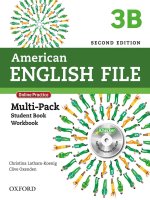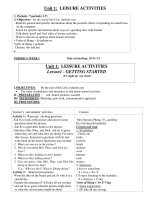American english file starter teachers book 2nd edition full kho tài liệu học tiếng anh
Bạn đang xem bản rút gọn của tài liệu. Xem và tải ngay bản đầy đủ của tài liệu tại đây (31.01 MB, 230 trang )
STARTER
SECOND EDITION
OXFORD
STARTER
,...
American
.I
<
•
. ,.· . . · · • · ·· .
-
--
"
- ~--
-
...
.
ENGLIS:H::;E,·I LE
;..
•
. :: _.··_·· ··-
•
.. :
.-
,_r
_... , ···-
•
.. ·--··
Teacher's Book
ns~~
Ln.
irLanguage
Christina Latham-Koenig
Clive Oxenden
with Margaret Brooks
o.J~I>.!I o.J~j ~.;t> 1.5~ ~ ~co..,.,~ 0-:!1
•.:...WI O~J ~ ~ J.ol:> 9 .b.Oo,J-! #
.::.J,.... ~
.~ ~lp ~~ J.oW. 9 .:......1 .;!bl 9 c~ · o.J~li .,jtL; o.JT ji1.5Jb.J-! ~
Paul Seligson and Clive Oxenden are the original co-aut hors of
English File 1 and English File 2
OXFORD
UN I VERSITY P RESS
Syllabus checklist
4
a Introduction
• What do beginning students need?
• Study Link
• Course components
Student Book Files 1-12
Back of the Student Book
• For students
Online Practice
Workbook
iChecker
Pronunciation App
• For teachers
Teacher's Book
iTools
Testing Program CD-ROM
Video
Class audio COs
12
126
Lesson plans
Photocopiable activities
Contents
Grammar activity answers
Grammar activity masters
Communicative activity instructions
Communicative activity masters
Vocabulary activity instructions
Vocabulary activity masters
Song activity instructions
Song activity masters
22s
Workbook answer key
3
---
- -- - -
-- -- --
4
Grammar
Vocabulary
4
A Hello!
verb be: I and you
numbers 0-10;
days of the week
6
8
verb be: he, she, it
countries
8
PRACTICAL ENGLISH How do you spcit it? ~ People on the street
Where ar e you f rom?
10
A
We're Canadian
verb be: we, you, they
nationalities
12
8
What's his number?
Wh- and How questions with be
numbers 11- 100;
personal information
14
REVIEW AND CHECK 1&2 ~ Short movies Friends
16
A What's in your bag ?
alan;
singular and plural nouns
small t hings
18
8
this I that I these I those
more small things
20
PRACTICAL ENGLISH How much is it? ~ People on t he street
22
A Family and friends
possessive adjectives;
possessive s
people and family
24
8 That's a cool carl
adjectives
colors and common adjectives
26
REVIEW AND CHECK 3&4 ~ Short movies A souvenir shop
28
A A bad hair d ay
simple present : I and you
common verbs 1
30
8
simple present: we, you, they;
Wh- questions
food and drink
32
PRACTICAL ENGLISH What t ime is it? ~ People on the street
34
A He speak s English at wor k
simple present: he, she, it
jobs and places of work
36
8
adverbs of f requenc y
a typical day
38
REVIEW AND CHECK 5&6 ~ Short movies The life of a chef
Is that a hat?
What do you have for breakfast?
Do you like mornings?
Reading
Pronunciation
Speaking
Listening
word stress;
/h/, /a1/, and Iii
introducing yourself
people introducing themselves
sentence stress;
Guess the countries
Can you hear the difference?
word stress; If / and l tfl
nationalities
understanding a dialogue
saying phone numbers;
sentence stress
Personal information
conversations between friends;
Can you hear the difference?
lzl and lsi; plural endings
things in your bag
Memory game
understanding short
conversations
li'JI and /ad
things in the classroom
at a souvenir stand
l:i, IAI, and larl
talking about your family
or friends
understanding a dialogue
Song: You're the First. the Last,
My Everything
I:JI, fu rl, and I:Jrl
talking about dream cars
/h/, /w/, and /v/; linking
talking about your lifestyle
A new haircut
understanding a longer
conversation
Song: I Want to Break Free
word stress;
a food questionnaire
an interview about food
breakfast around the world
third p erson - s;
word and sentence stress
talking about people who w ork
understanding a dialogue
English: The Language of
Business
sentence stress
qu estionnaire:
Do you like mornings?
an interview
Song: Wonderful Tonight
A Day in the Life of
Simon Cowell
Ill, fool, and lcl
on the train
What car? Men and women
are different
l tfl, ld:J, and /g/
5
6
Grammar
Vocabulary
40
A Life at the end of the world
word order in questions
common verbs 2
42
B
can/can't
common verbs 2
44
PRACTICAL ENGLISH What's the data today? . . . People on the street
You can't park here
46
A What are they doing?
present continuous
verb phrases
48
B Today is different
present continuous or simple present?
the weather
50
REVIEW AND CHECK 7&B . . . Shorhmovies A day off
52
A In the jungle in Guatemala
there is I there are
hotels; in, on, under
54
B Before they were stars.-
simple past : be
in, at, on: places
56
PRACTICAL ENGLISH Is there a bank near here? . . . People on the street
58
A It changed my life
simple past: regular verbs
common verbs 3
60
B What did you do?
simple past: do, get, go, have
daily routine verbs;
irregular verbs
62
REVIEW AND CHECK 9&10
64
A What do you think of it?
object pronouns: me, him, etc.
opinion words
66
B
simple past: more irregular verbs
common verbs 3;
irregular verbs
70
A A Trip of a lifetime
future: be going to
future time expressions
72
B From startto finish
review of present, past, and future
review of verb collocations
74
REVIEW AND CHECK 11&12 . . . Short movies Trip of a lifetime
76
Communication
86
Listening
116
Vocabulary Bank
84
Writing
92
Grammar Bank
132
Sound Bank
Strangers on a train
Pronunciation
Speaking
Listening
Reading
lcrl, lui, lad, and /y/
talking about free time
activities
Weekdays and weekends
an interview
an interview about living in
Ushuaia
/a:/ and /a/;
sentence rhythm
Can you...?
understanding dialogues
ld, l ui, and 11)1
things people are doing
Song: Singing in the Rain
l::i, lou/, and /e1/
an interview
lcr/, llr/, and 1-:Jll
Is there a TV? Where is it?
/;,r/ and was I were
Where were they?
regular simple past endings
talking about past events
sentence stress
Life in a day
Song: Where Did Our Love Go?
strong stress
talking about music
a conversation about musicians
silent consonants
answering questions about a
story
Strangers on a train
Strangers on a train
sentence stress
future plans: a dream trip
a radio interview
Song: I Can See Clearly Now
My Adventure Begins!
review of sounds
a review of present, past and
future
a letter and an email
Working on vacation
understanding a dialogue
Amazing Hotels!
I laughed, I learned, I changed ...
Movie shows life around
the world
1
American EnBlish File Second Edition is; h integrated skills
series that gets students talking- in class.and everywhere.
Our goal with this Second Edition has b '!n to make every
lesson better and more student- and teac •er-friendly. In
addition to Student Book Lessons A andl ~.there is a range
of material that you can use according tc rour students'
needs and the time and resources you ha< e available:
• Practical English video and exercises .!so available on
class audio)
• Review and Check pages, with video
• Photocopiable Grammar, Vocabular_>iCommunicative,
and Song activities (in the Teacher's i!Jok)
STUDYI:!m3 Online Practice, Workboo'o iChecker, and the
Pronunciation app provide multimedia n eiew, support, and
life stories and situations, humor, and suspense. The
Grammar Banks, at the back of the book, give students
a single, easy-to-access grammar reference section, with
clear rules, example sentences with audio, and common
errors. There are at least two practice exercises for each
grammar point.
Vocabulary
Beginning students need
• to rapidly expand their knowledge ofhigh-frequency
words and phrases.
• to use new vocabulary in personalized contexts.
• accessible reference material.
practice for students outside of class.
:.;;;;;;:,:;;.;;;;,;;;;;;;;;;;o. ~==
The Teacher's Book also suggests differer t ways of
exploiting many of the Student Book actr•ities depending
on the level of your class.
~~
!illlD
What do beginning students need?
......._..._.........
In nine out of ten cases, when a student signs up for English
classes, their goal is to speak. Speaking a foreign language
is very hard, so students need a lot of motivation to
encourage them to speak in English.
Grammar, Vocabulary, and Pronunciation
At any level, the tools students need to speak English with
confidence are Grammar, Vocabulary, and Pronunciation
(G, V, P). We believe that G + V + P =confident speaking,
and in American EnBlish File Second Edition, all three
elements are given equal importance. Each lesson has clearly
stated grammar, vocabulary, and pronunciation goals. This
keeps lessons focused and gives students concrete learning
objectives and a sense of progress.
______
..,......,
tl:~w
·--¥- ......_
i§~
.~m
__
·-··-·-·-_
_
--- --..._...
.("_...
lp
--1
_...._
.--~-_
.....................
-
........
Every lesson focuses on high-frequency vocabulary and
common lexical areas, but keeps the load realistic. All new
vocabulary is given with the phonetics, to help students
with the pronunciation of new words. Most lessons are
linked to the Vocabulary Banks at the back of the book,
which help present and practice the vocabulary in class, give
an audio model of each word, and provide a clear reference
so students can review and test themselves on their own.
Grammar
Beginning students need
• clear and memorable presentations of new structures.
• plenty of regular and varied practice in useful and
natural contexts.
• student-friendly reference material.
1
3
lo\• 1 4'l_ _ .... tu4 __
...._
,.~~----
~ :.:~
-~ -~!.
-~ _';j<>
~ 1~(~.
-
~~
-
~--
~-
___
ai
ay
•
name late
email Spain
day say
eight they
great
n
.
·--------·~---
_____
....
·- __
,._ _
............
American EnBlish File Second Edition provides contexts
for new language that will engage students, using real-
8
a*
-·-
.,._
. ----------·------·-·
·---
Beginning students need
• to learn the English vowel and consonant sounds and
practice them intensively.
• to see where there are rules and patterns in
sound-spelling relationships.
• systematic practice of other aspects of pronunciation,
e.g. stress and rhythm.
" ___ - .....
.
r§.:;::·---- '
...... __..
?!..: ~~
1
...__
, _ ·--·---·····-·-·-..·......... -
Pronunciation
Beginning learners want to speak clearly but are often
frustrated by English pronunciation, particularly the
sound-spelling relationships, silent letters, and weak
forms. We emphasize improving pronunciation by
focusing on the sounds most useful for communication,
on word stress, and on sentence rhythm. American EnBlish
File Starter has a pronunciation focus in every lesson that
targets sounds, word stress, or sentence stress.
students to read is to give them motivating but accessible
material and tasks they can do . American English File Starter
reading texts are staged so that they progress from one-line
sentences to short articles adapted from a variety of real
sources (newspapers, magazines, news websites). These
articles have been chosen for their intrinsic interest.
Speaking
Beginning students need
• topics that will inspire their interest.
• realistic and achievable tasks.
• regular opportunities to use new la nguage orally.
American English File Second ~ - - Edition motivates students
__,._"""-- to speak by providing them
::::.~"':~..§;
with varied and motivating
gu=--·
tasks, a nd the language
(grammar, vocabulary,
and pronunciation)
that they need in order
=-~- -~---~
~
_
---
-~
- --· ;:::-~~
.-~
___
tocommunicatewith
:(.D
__ 1: =-illl
- "'.,.1
.: confidence. In addition to the
~ ~
Communication activities
fe\1
1
at the back ofthe book,
'J ~
• S·S:~::=:=,::::=.
=:- ==students are encouraged to
speak throughout the lesson,
responding to texts a nd listenings, and practicing grammar
and vocabulary orally.
11•
Listening
Beginning students need
• to be exposed to as much aural English as possible.
• to build their confidence by listening to short and
simple utterances.
• to learn to get the gist of what is being said by focusing on
the key words in an utterance.
The listenings in American English File Starter are based on
a variety ofentertaining and realistic situations. There is a
wide range of voices and accents from the US and the rest of
the English-speaking world, but all the speakers are clear and
comprehensible to students at this level. T he performances
and the sound e ffects bring the listenings alive, and make the
recordings easier for students to follow and more fun to listen
to. The tasks focus o n helping students to get the gist the first
time and then be able to understand more the second time.
Writing
Beginning students need
• clear models.
• the "nuts and bolts" of writing o n a word and sentence level.
T he growth of the Internet
and email means that
people worldwide are
writing in English more
than ever before, both for
business and personal
communication. American
EnBlish File Starter provides
guided writing tasks with
a range of writing types
from formal email to social
networking posts.
Writmg
.
•.
~ ~ ~
·=-----
...---·- ......_...
___
1
Practical English
Beginning students need
• to learn high-frequency fu nctional phrases.
• to know what to say in common situations.
The six Practical English lessons give students practice
in key language for situations suc h as ordering coffee and
asking about price. To make these everyday situations
come alive, there are People on the Street sections in every
Practical English lesson, in which students watch or listen
to real people - not actors - use the key language in real-life
situations. The Practical English video is on the American
EnBlish File Starter DVD and iTools. Teachers can also
u se the Practical English Student Book exercises with the
Class Audio COs.
Reading
Review
B e ginning students n eed
• engaging topics and stimulating texts.
• m a nageable tasks that help students to read.
• to learn how to deal with unknown words in a text.
7A
s~ --~
.
L1f e at the end of the w orld
--~'""-·- · --
:g~
:~=·
·-·--·-·------...
..... ...
·--
·-f'IOM ·l -. -·- . .
'








